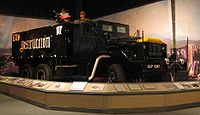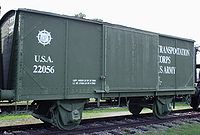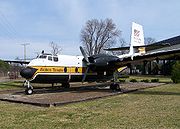
U.S. Army Transportation Museum
Encyclopedia
The U.S. Army Transportation Museum is a United States Army
museum
of vehicles
and other transportation
-related equipment and memorabilia. It is located on the grounds of Fort Eustis, Virginia
, in Newport News
, on the Virginia Peninsula
.
exhibits opened in 1987. The buildings, built at a total cost of US$765,000, and other capital improvements are funded by the Army Transportation Museum Foundation (ATMF). Since the foundation is prohibited by law from obtaining state or federal grants, private donations are the only funding source.
, and includes close to 100 military vehicles such as land vehicles, watercraft and rolling stock, including stock from the Fort Eustis Military Railroad
. It is officially dedicated to General Frank S. Besson, Jr.
, who was the first four-star general to lead the transportation command, and extends over 6 acres (24,281.2 m²) of land, air and sea vehicles and indoor exhibits. The exhibits cover transportation and its role in US Army operations, including topic areas from the American Revolutionary War
through operations in Afghanistan
.

 The museum features a 50000 square feet (4,645.2 m²) main building and four outdoor parks.
The museum features a 50000 square feet (4,645.2 m²) main building and four outdoor parks.
The exhibits inside the museum building include representative transportation-related materials, presented in a series of dioramas in chronological order. Outside (see map, below) there is a vehicle yard to the south, with road vehicles, amphibious craft, and the aircraft pavilion, and a rail exhibit to the north. Although material is presented on 18th- and 19th-century topics, over half the indoor exhibit space and almost all of the outdoor exhibits are 20th-century- related.
Early truck developments are given coverage with the Mexican Punitive Expedition, Liberty truck
, and Transcontinental Motor Convoy exhibits. The extensive Liberty Truck exhibit covers the development and production of the Army's first standardized truck design, a 5 ton cargo hauler produced using interchangeable parts as well as soldier letters about their experiences with the trucks.
World War II
receives coverage with several exhibits. Among them are coverage of Operation Mulberry
, which was an operation to construct two artificial harbors on the Normandy coast to support the invasion. This operation used 158 tugboats including 74 of the Army's "small tugs" to tow 59 Gooseberry
derelict ships to be sunk as breakwalls and the Phoenix caissons and Lobnitz floating piers. Another exhibit focuses on the Red Ball Express
, the massive supply operation that supported Patton
's advance after D-Day
. Coverage includes photos and paintings of the trucks as well as a diorama of a rest stop/repair depot featuring cargo trucks and a wrecker. Additional materials address the massive fuel and oil consumption needs as well as soldier experiences.
The museum has an extensive Vietnam War
exhibit, including a large diorama with the gun truck
Eve of Destruction (believed the only surviving Vietnam era gun truck, and named after a protest song) and a helicopter, as well as bicycles used by the Viet Cong. The museum has an extensive collection of gun truck images, organised by the truck name, which are also on the museum's web site.
Outdoor exhibits include the vehicle park with a selection of representative vehicles used in the transport command. A marine park has Army water vessels, including a DUKW
and a tugboat and various sized amphibious craft including landing craft and wheeled barges.
 The aviation pavilion exhibits aircraft, fixed wing and helicopter, from the Korean War
The aviation pavilion exhibits aircraft, fixed wing and helicopter, from the Korean War
to the present, including a HZ-1 Aerocycle, an OH-23 Raven helicopter and a vertical take-off/landing plane. An unrestored Avrocar is in the covered section.
The rail section has several significant artifacts including the railway cars used in the Berlin duty train as well as standard issue tank switchers, and a collection of typical rolling stock including cranes, freight cars and maintenance of way equipment.
United States Army
The United States Army is the main branch of the United States Armed Forces responsible for land-based military operations. It is the largest and oldest established branch of the U.S. military, and is one of seven U.S. uniformed services...
museum
Museum
A museum is an institution that cares for a collection of artifacts and other objects of scientific, artistic, cultural, or historical importance and makes them available for public viewing through exhibits that may be permanent or temporary. Most large museums are located in major cities...
of vehicles
Military vehicle
A military vehicle is a vehicle that includes all land combat and transportation vehicles, which are designed for or are in significant use by military forces throughout the world. Vehicles that are armored or intended for combat are often referred to as armoured fighting vehicles....
and other transportation
Military Supply Chain Management
Military supply chain management is a cross-functional approach to procuring, producing and delivering products and services. The broad management scope includes sub-suppliers, suppliers, internal information and funds flow.-Supply:...
-related equipment and memorabilia. It is located on the grounds of Fort Eustis, Virginia
Virginia
The Commonwealth of Virginia , is a U.S. state on the Atlantic Coast of the Southern United States. Virginia is nicknamed the "Old Dominion" and sometimes the "Mother of Presidents" after the eight U.S. presidents born there...
, in Newport News
Newport News, Virginia
Newport News is an independent city located in the Hampton Roads metropolitan area of Virginia. It is at the southeastern end of the Virginia Peninsula, on the north shore of the James River extending southeast from Skiffe's Creek along many miles of waterfront to the river's mouth at Newport News...
, on the Virginia Peninsula
Virginia Peninsula
The Virginia Peninsula is a peninsula in southeast Virginia, USA, bounded by the York River, James River, Hampton Roads and Chesapeake Bay.Hampton Roads is the common name for the metropolitan area that surrounds the body of water of the same name...
.
History
The museum was established in 1959, in a warehouse using items initially collected for a recruiting exhibit, and got a main building in 1976. An open-air pavilion for aviationMilitary aviation
Military aviation is the use of aircraft and other flying machines for the purposes of conducting or enabling warfare, including national airlift capacity to provide logistical supply to forces stationed in a theater or along a front. Air power includes the national means of conducting such...
exhibits opened in 1987. The buildings, built at a total cost of US$765,000, and other capital improvements are funded by the Army Transportation Museum Foundation (ATMF). Since the foundation is prohibited by law from obtaining state or federal grants, private donations are the only funding source.
Museum mission
The museum reflects the history of the Army, especially of the United States Army Transportation CorpsUnited States Army Transportation Corps
The Transportation Corps was established 31 July 1942 by Executive Order 9082. The Transportation Corps is a combat service support branch of the U.S. Army, and was headquartered at Fort Eustis, Virginia, but has now moved to Fort Lee, Virginia. The Transportation Corps is responsible for the...
, and includes close to 100 military vehicles such as land vehicles, watercraft and rolling stock, including stock from the Fort Eustis Military Railroad
Fort Eustis Military Railroad
The Fort Eustis Military Railroad is an intra-plant United States Army rail transportation system existing entirely within the post boundaries of the United States Army Transportation Center and Fort Eustis , Fort Eustis, Virginia...
. It is officially dedicated to General Frank S. Besson, Jr.
Frank S. Besson, Jr.
Frank Schaffer Besson, Jr., CBE was born on May 30, 1910 in Detroit, Michigan. His father was a West Point graduate and an officer in the Corps of Engineers . Frank S. Besson, Jr. graduated seventh in his class from the United States Military Academy in 1932. In 1935, he received a master's...
, who was the first four-star general to lead the transportation command, and extends over 6 acres (24,281.2 m²) of land, air and sea vehicles and indoor exhibits. The exhibits cover transportation and its role in US Army operations, including topic areas from the American Revolutionary War
American Revolutionary War
The American Revolutionary War , the American War of Independence, or simply the Revolutionary War, began as a war between the Kingdom of Great Britain and thirteen British colonies in North America, and ended in a global war between several European great powers.The war was the result of the...
through operations in Afghanistan
War in Afghanistan (2001–present)
The War in Afghanistan began on October 7, 2001, as the armed forces of the United States of America, the United Kingdom, Australia, and the Afghan United Front launched Operation Enduring Freedom...
.
Exhibits


The exhibits inside the museum building include representative transportation-related materials, presented in a series of dioramas in chronological order. Outside (see map, below) there is a vehicle yard to the south, with road vehicles, amphibious craft, and the aircraft pavilion, and a rail exhibit to the north. Although material is presented on 18th- and 19th-century topics, over half the indoor exhibit space and almost all of the outdoor exhibits are 20th-century- related.
Early truck developments are given coverage with the Mexican Punitive Expedition, Liberty truck
Liberty truck
-History:The liberty truck was designed by the Motor Transport section of the Quartermaster Corps in cooperation with the members of the Society of Automotive Engineers....
, and Transcontinental Motor Convoy exhibits. The extensive Liberty Truck exhibit covers the development and production of the Army's first standardized truck design, a 5 ton cargo hauler produced using interchangeable parts as well as soldier letters about their experiences with the trucks.
World War II
World War II
World War II, or the Second World War , was a global conflict lasting from 1939 to 1945, involving most of the world's nations—including all of the great powers—eventually forming two opposing military alliances: the Allies and the Axis...
receives coverage with several exhibits. Among them are coverage of Operation Mulberry
Mulberry harbour
A Mulberry harbour was a British type of temporary harbour developed in World War II to offload cargo on the beaches during the Allied invasion of Normandy....
, which was an operation to construct two artificial harbors on the Normandy coast to support the invasion. This operation used 158 tugboats including 74 of the Army's "small tugs" to tow 59 Gooseberry
Gooseberry
The gooseberry or ; Ribes uva-crispa, syn. R. grossularia) is a species of Ribes, native to Europe, northwestern Africa and southwestern Asia...
derelict ships to be sunk as breakwalls and the Phoenix caissons and Lobnitz floating piers. Another exhibit focuses on the Red Ball Express
Red Ball Express
The Red Ball Express was an enormous truck convoy system created by Allied forces to supply their forward-area combat units moving through Europe following the breakout from the D-Day beaches in Normandy. The term "Red Ball" was a railroad phrase referring to express shipping...
, the massive supply operation that supported Patton
George S. Patton
George Smith Patton, Jr. was a United States Army officer best known for his leadership while commanding corps and armies as a general during World War II. He was also well known for his eccentricity and controversial outspokenness.Patton was commissioned in the U.S. Army after his graduation from...
's advance after D-Day
D-Day
D-Day is a term often used in military parlance to denote the day on which a combat attack or operation is to be initiated. "D-Day" often represents a variable, designating the day upon which some significant event will occur or has occurred; see Military designation of days and hours for similar...
. Coverage includes photos and paintings of the trucks as well as a diorama of a rest stop/repair depot featuring cargo trucks and a wrecker. Additional materials address the massive fuel and oil consumption needs as well as soldier experiences.
The museum has an extensive Vietnam War
Vietnam War
The Vietnam War was a Cold War-era military conflict that occurred in Vietnam, Laos, and Cambodia from 1 November 1955 to the fall of Saigon on 30 April 1975. This war followed the First Indochina War and was fought between North Vietnam, supported by its communist allies, and the government of...
exhibit, including a large diorama with the gun truck
Gun truck
A military gun truck is an improvised fighting vehicle used by units of regular armies or other official government armed forces, based on a conventional cargo truck, that is able to carry a large weight of weapons and armor...
Eve of Destruction (believed the only surviving Vietnam era gun truck, and named after a protest song) and a helicopter, as well as bicycles used by the Viet Cong. The museum has an extensive collection of gun truck images, organised by the truck name, which are also on the museum's web site.
Outdoor exhibits include the vehicle park with a selection of representative vehicles used in the transport command. A marine park has Army water vessels, including a DUKW
DUKW
The DUKW is a six-wheel-drive amphibious truck that was designed by a partnership under military auspices of Sparkman & Stephens and General Motors Corporation during World War II for transporting goods and troops over land and water and for use approaching and crossing beaches in amphibious...
and a tugboat and various sized amphibious craft including landing craft and wheeled barges.

Korean War
The Korean War was a conventional war between South Korea, supported by the United Nations, and North Korea, supported by the People's Republic of China , with military material aid from the Soviet Union...
to the present, including a HZ-1 Aerocycle, an OH-23 Raven helicopter and a vertical take-off/landing plane. An unrestored Avrocar is in the covered section.
The rail section has several significant artifacts including the railway cars used in the Berlin duty train as well as standard issue tank switchers, and a collection of typical rolling stock including cranes, freight cars and maintenance of way equipment.

